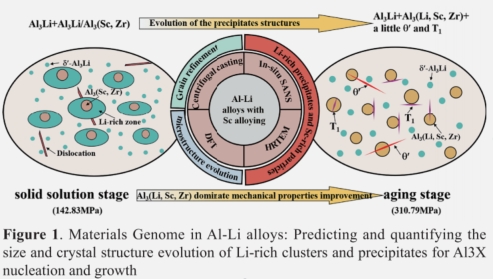Junsheng Wang
1 School of Materials Science and Engineering, Beijing Institute of Technology, Beijing 100081, China
2 Advanced Research Institute of Multidisciplinary Science, Beijing Institute of Technology, Beijing 100081, China
EXTENDED ABSTRACT: The size distribution and structural evolution of the precipitates are critical to the mechanical properties of heat treatable alloys. In Al-Li alloys, many studies have reported that monodisperse core—shell Al3Li/AliZr, Sc) structures in a Li-rich enviromnent promote formation of o'-Al3Li, Tl-Al2CuLi, and 8'-Al2Cu precipitates. However, without quantitative measurements of the precipitate size distribution and tracking their crystal structure evolution, the kinetics of Lirich clusters and excessive Li diffusion into monodisperse core—shell Al3(Zr, Sc) structures in Al alloys to prevent Li-cluster coarsening is largely unknown. In this presentation, in-situ small angle neutron scattering (SANS) has been adopted to track the evolution of O-Al3Li precipitates. Upon quenching, Li-rich clusters remain at a smaller size and higher number density. Once aging starts, nucleation of o'-Al3Li precipitates on top of Ali Zr, Sc) is at the expense of dissolution of those Li-rich clusters below the critical size. From density functional theory (DFT) calculations, it has been found the 6'-Al3Li precipitate nucleation barrier on top of Ali Zr, Sc)s negligible, as well as the nucleation barrier of -Al2Cu on top of AliZr, Sc) is much lower relative to that on -AL Besides, the substitutional energy for Li to replace Zr and Sc sites in AllZr, Sc) is favorable. Combining SANS with high-resolution transmission electron microscopy (HRTEM), the effects of AliZr, Sc) cores on preventing o'-Al3Li size from coarsening by absorbing Li to form Al3(Li, Zr, Sc) have been uncovered. Simultaneously, the contributions of AllLi, Sc, Zr) particles and'-Al3Li to the strength has been quantified and new alloys have been designed to utilize the precipitating kinetics at the presence of monodisperse precursors for industrially relevant light-weight structural Al-Li alloys.
Keywords: Al-Li; Precipitation; SANS; DFT; HRTEM; ICME
References
[l] C. Xue, S. Wang, Y. Zhang, G. Tian, X. Yang, X. Chang, Y. Ke, Z. Xie, J. Wang*, Mater. Sci. & Eng. A 881 (2023) 145393

Junsheng Wang is a Professor and the director of the Integrated Computational Materials Engineering(ICME) laboratory, Advanced Research Institute of Multidisciplinary Science (ARIMS), Beijing Institute of Technology(BIT). His research focus is on the design and manufacturing of ultra-light structural materials such as Mg-Li and Al-Li alloys, using ICME. He has published over 100 scientific papers in SCI-indexed journals, filed over 40 patents on Al and Mg alloys, and awarded several research grants to develop next generation light alloys. He is a member of the editorial board of several scientific journals including "Aeronautical Manufacturing Technology", "Special Casting Nonferrous Alloys", and technical books such as the ASM Handbooks.